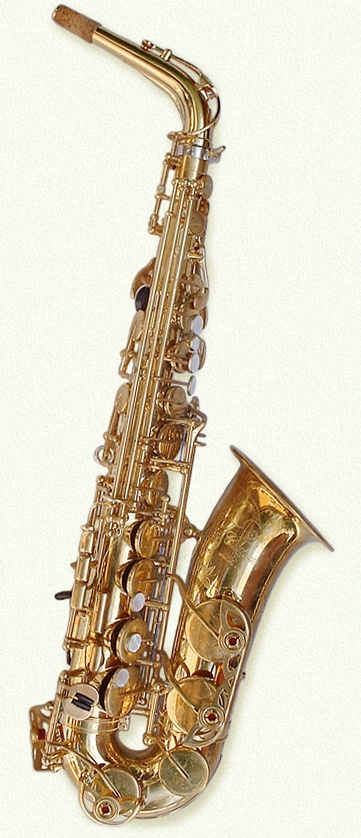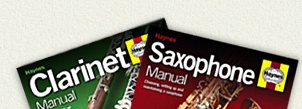Yamaha YAS82Z alto saxophone (unlacquered model)
 Origin:
Japan (uk.yamaha.com) Origin:
Japan (uk.yamaha.com)
Guide price: £2900
weight: -
Date of manufacture: 2005 (approx)
Date reviewed: September 2005 (Addendum added,
see below)
A new benchmark for Yamaha pro altos...or an old
wolf in a new coat?
This could turn out to be one of my briefest reviews yet.
I think I can tell you everything you need to know about the build quality
of the Z series alto by referring you, in turn, to the review of the YAS62
for the keywork followed by the review of the Z
series tenor for any bodywork issues.
Really, that pretty much sums it up. I could add that this model was the
unlacquered version. The manufacturers would have you believe that this
makes the horn more responsive. I remain unconvinced, mostly through having
stripped lacquer off horns for clients and having been able to assess
the results without any expectations.
What I can tell you is that unlacquered brass gets pretty dirty
pretty quickly, and whilst this might look funky (in the grooviest
sense of the word) it's just as likely that it might look bloomin'
awful. I've seen my share of green MKVI's, I can tell you.
As it came, the horn had quite the highest action I have ever seen on
a horn. My client informed me that it was set up this way by the seller
in an effort to resolve some 'tuning issues'. All I have to say on the
matter is that it didn't work, and nor was it likely to. The springing
was set heavy too, which really knackers the feel of what is one of the
slickest actions on the market.
There were a few keywork issues to address, mostly involving pillars that
had been knocked out of line. I've never seen this on any decent new horn,
and I'm certain this would have been down to a spot of rough handling
in shipping.
As per the Z tenor, the horn comes with a smart and substantial case.
I guess we can all nip off to the pub now.
Oh no, wait...I need to talk about the tuning...
If you've done any research on the web about Yamaha's Z series horns
you'll have probably come across a number of articles related to tuning
issues with this range of horns. As mentioned in my review of the Z
series tenor some people have experienced problems with certain crooks,
and indeed it was for this reason that this horn was brought into the
workshop.
In this particular case the owner had noticed a very flat mid C#.
I don't mind admitting that I was initially sceptical, and set about
blowing the horn with a view to demonstrating that there was nothing
wrong with the horn that a little long note practice couldn't resolve.
I was wrong - there WAS a distinct flatness to the C#, and not
one that could be considered 'lippable' by any stretch of the imagination.
The strangest thing was that it seemed to be confined to this one
note, with the rest of the horn being reasonably well in tune.
When I first clapped eyes on this horn I noted what I considered
to be a very slight bend in the crook. It can be very hard to determine
whether a crook has a subtle bend in it - there are a lot of angles
in play, and reflected light can play tricks on the eye, but as
I ran my fingers round the crook I felt that there was perhaps just
the hint of ovalness, and the light didn't seem to run true over
the curves. It also fitted in with the problems I noticed with a
couple of the pillars - at some point in its short life I think
this horn has copped a bit of a whack. The client was adamant that
he'd barely touched it since new, and that if there were any mechanical
problems with it then it would have had them when it arrived from
the retailer.
As it happened, I had my trusty old YAS62 in the workshop - so just
for the hell of it I popped the crook off it onto the Z and gave it a
blow. The result was remarkable! That rotten old C# snapped into pitch,
and indeed the whole horn took on a completely new sense of stability
pitchwise. The difference was staggering, seriously.
It was at this point that I decided to redress the business of the excessively
high action, As mentioned earlier, the action had been set high by the
seller's techs in a bid to resolve the tuning issues. Having reset the
action to a normal height we found that it made no difference to the tuning,
for better or worse (no surprises there).
Now, it remains to be seen whether this was a one-off. If it's the case
that the Z's crook was damaged at some point then it seems reasonable
to assume that a simple direct replacement will suffice.
If, on the other hand, it transpires that the problem persists with a
replacement crook then clearly the finger has to be pointed at the design
of said crook. My test with the 62's crook rules out any inherent tuning
problems with the body of the horn itself.
That being said, there are options with regards to the crooks on the Z
series. This model came with the G1 crook. I'd be inclined to try a replacement
- and if that fails to resolve the problem I'd go for the M1 crook. If
that fails too then it's a case of reverting to the 62 crook, or looking
to aftermarket options such as a Ponzol or a Gloger etc.
I've advised the client to contact either the seller or Yamaha to arrange
for a replacement crook (see addendum below).
The business of swapping over the crook threw up some interesting
comparisons with regard to the tone of the Z - and I think my own
impression of the Z alto is that it's essentially a souped-up YAS62.
Playing the two horns side by side reveals an extremely close similarity
tonewise - except that the Z is rather more free blowing. There's
less resistance, more clarity, and the sound is fatter. I can think
of no better description than to say that it's as though the YAS62
comes with a cloth draped over its bell. Remove it, and you get
the sound of the Z alto.
It was interesting to note that a lot of this seemed to be down to the
crook. Although the 62's crook improved the Z's tuning enormously, it
also took away some of the openness and midrange, bringing the Z closer
in response to the 62...almost identical, I'd say.
This throws up an interesting proposition. Given that the Z uses the
62's keywork and feels pretty much the same, and given that the price
difference between the 62 and the Z is substantial, I'm left wholly convinced
that you can make make a "poor man's Z" simply by replacing
the crook on the 62 with something more esoteric.
I noted in the review of the Gloger
crook how it opened up the midrange of the 62, and as the 62
sells at about the £1100 mark, and the Z at £1800, that
gives you £700 or so to play with. A Gloger comes in at about
£300, you might get a few bob back on the original crook -
so you could save yourself a good few hundred quid. At the very
least it gives existing 62 owners a chance to 'step up' to the Z
series if they so wish - and if it proves that the Z series crooks
aren't that hot on tuning then 62 owners might find a ready market
for their old crooks...
All in all I'm very impressed with the Z alto - much more so than I was
with the tenor. I've always said that Yamaha should make a 'super Yamaha',
and perhaps this is it. Then again, it's interesting to note how strikingly
similar it is to the 62.
It gets my recommendation as a serious horn player's horn, as long as
you're prepared to spend some time checking that the crook as supplied
works for you. Other than that, stick with a 62 and have some fun with
crook/mouthpiece combinations and save yourself a few bob.
As and when I get feedback from the owner regarding a change of crook
I'll post the results here in an addendum.
Addendum 05/11/05:
The owner of this particular horn arranged to try some replacement crooks
at a Yamaha dealer, but this failed to resolve the tuning problems.
He then contacted Yamaha to see what they could do, and was rather surprised
to be told that Yamaha doesn't have a worldwide support policy (the
horn was bought in another country). I was amazed and appalled to
hear this - I mean, what is Yamaha if not a global brand...and what's
the point of making and selling a professional quality product if
you don't expect your professional clients to do inconvenient things
like take gigs abroad?
Anyway, with some small 'persuasion' (and I'll leave that up to you to
imagine what that might have been) Yamaha reconsidered its position and
arranged for the client to try out a brand new Z alto - which was found
to be spot on with regard to tuning. 'Nuff said.
All's well that ends well then - though I have now placed a question
mark beside the date of manufacture for the following reason: The original
horn as reviewed bore the serial number 145xxx and the replacement 245xxx
- and I have a sneaking suspicion that the horn may have been 'old stock'.
There were comments posted on the web a year or so ago with regard to
tuning issues with the Z series horns, and it was noted that Yamaha had
taken steps to correct such supposed anomalies.
|



